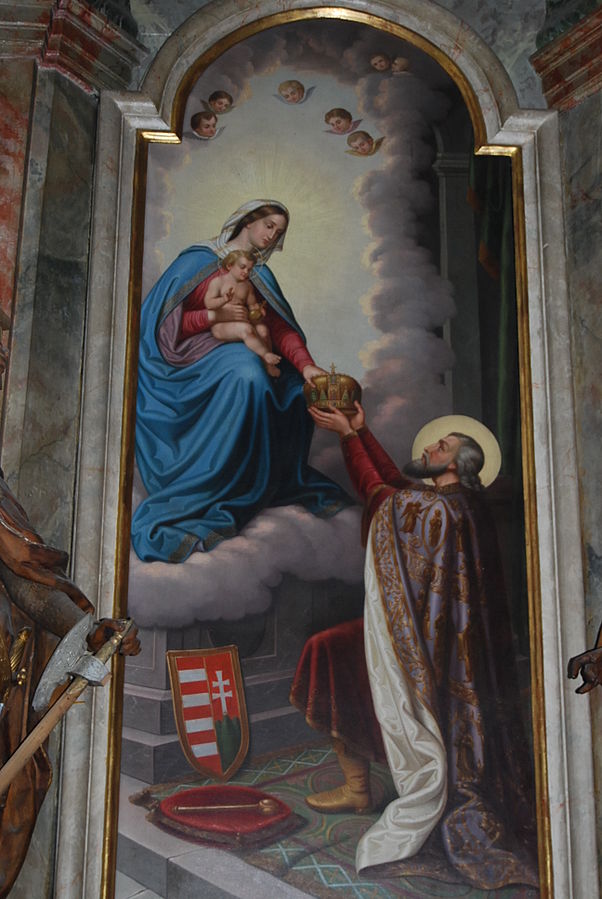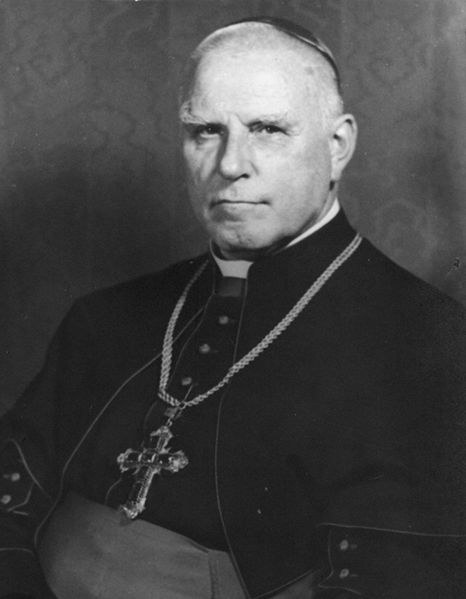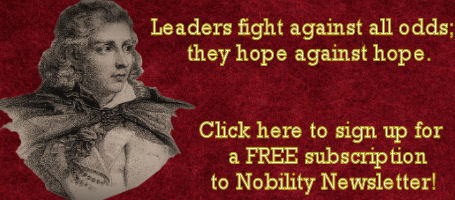Continued from Part IV
Saint Stephen as Warrior and Judge
Another summary, also on St. Stephen, catches aspects of his personality as warrior and judge.
“To the piety and zeal of an apostle St. Stephen of Hungary joined the courage of a warrior and hero. In his instructions to his son, St. Emeric, he noted that he spent almost all his life at war repelling invasions by foreign nations. Still a duke when he was about to ascend to the throne (he was a duke until his conversion, when the Pope elevated him to the dignity of King of Hungary) he tried to keep the peace. However, under his noblemen, his still pagan subjects revolted, pillaged cities and fields, killed his officers, and insulted the Duke himself.
“The Duke gathered his troops and led them against the rebels besieging Vesprin, showing in his standard an image of St. Martin and St. George. Having defeated them, he consecrated his lands to God. In 1002, when his uncle Djula, coming from Transylvania, attacked Hungary several times, Stephen also marched against him, took him and his family captive, and annexed his states to the Hungarian monarchy. He defeated Ken, Duke of Bulgarians and killed him with his own hands. With the same success he repelled the Bessos, a neighboring people of Bulgaria. But his righteousness equaled his valor. Attracted by his fame, 60 noblemen from Bessos – the country he defeated – left their land with their families and fortune and asked the holy king permission to settle in the kingdom of Hungary.
“Driven by greed, the servants of a border commander attacked them by surprise, killed some, wounded others and stole their property. St. Stephen summoned the commander and his troops to the court. He reproached them for their inhumanity and condemned them to the same fate they meted out to their victims. He immediately had them hanged in pairs in all avenues of the kingdom so that everyone would know that Pannonia – as Hungary was then called – was open to foreigners, who would find in it hospitality and protection.”
The Church and harmonious opposites
Here you find true wonders of the Catholic Church which can never be sufficiently emphasized.
In general, when you see an accusation against the Church you should look for its one sidedness. Because in general, when you have an historical charge there is a lie involved. When you have a doctrinal charge, you find one sidedness. They take only one aspect of the Church and attack her because they only see that aspect. They do not want to take into account the fact that the Church as a whole has a harmony of opposite but related aspects that compose the whole beauty of the Church, as indeed the beauty of the universe, the order created by God.
One cannot truly have the spirit of the Church and therefore the spirit of the TFP if one’s eyes are not turned to this reality and if one is not enthused about this truth.
We must see in St. Stephen these two harmonious opposites
Take St. Stephen the King in contrast to any “white heresy” [i] devotee that enters a church to pray. What I would like to praise in St. Stephen is precisely this aspect of warrior and saint, for one thing completes the other and together they provide the full physiognomy of St. Stephen: the face of a saint canonized by the Church and therefore, the face of the Church that canonized this saint. For when the Church canonizes a saint she declares that he had her spirit in a perfect way. And therefore every saint is, in his own way, an image of the spirit of the Church.
Thus, even if we reason with an elementary logic and a modicum of common sense we find a full justification of both aspects of St. Stephen’s life.
Firstly, note his manly and energetic aspect. He is grappling with sworn enemies who hate him because he is not a pagan and who want to depose him because he seeks to bring the light of the Gospel to his people; so they rise up against him within his kingdom and also from the outside to exterminate him and his men, the portion of the Hungarian nation that embraced the true faith. These men are invaders, rebels and enemies of the eternal salvation of the Hungarian people. But at the same time (a secondary point that should be considered), they are enemies of the sovereignty of the Hungarian people and of their right choose the true faith, to heed the call of Our Lord Jesus Christ. Finally, they are enemies of that perfect freedom which man has when he says yes and obeys God.
Therefore, St. Stephen saw his people attacked in their highest spiritual goods, faith being the source of all spiritual goods, and also attacked in their own sovereignty because a nation’s badge of sovereignty is the same thing as a man’s seal of freedom.
Man’s freedom and a nation’s freedom consist in being able to obey and serve God without constraint. This is the very definition of freedom. And to deny the Hungarian people that freedom is to deny their sovereignty in its very essence. To deny it was (a tertiary but still important notion) to compromise the whole progress of the Hungarian people, for we know that Catholic civilization, by fully corresponding to the principles of the natural order and giving man the supernatural forces needed to obey the principles of natural order is the source of all good and of all temporal and material greatness.
Consequently, trying to distance a country from the Catholic faith is to seek to keep it in abject paganism and to divert it from true progress. Accordingly, in St. Stephen’s struggle was engaged all that was for Hungary a reason for being and living.
To attack a king is to destroy the resistance of his people
Now consider the Besso people who, led by a very bad man (he who tries to prevent another people from heeding the voice of Our Lord is very bad), filled with elements full of hatred to the Catholic religion and thus touched by the devil, attack the Hungarian people.
We know well that at that time the king was the soul of his country and the center of its resistance. The way to dismantle that resistance was to kill the king. So, if someone had to kill the king, was it not beautiful, symbolic and noble for the holy king to kill the pagan king with his own sword and with his own hands? Isn’t this what should be done, a king punishing another king and the royal blood of an evil king being shed at the hands of a good king? And for the infamy committed by a royal hand to be redressed by the fidelity of another royal hand? Isn’t this what it should be? Isn’t this really noble and beautiful?
So, by defending his people and the Holy Catholic Church St. Stephen fulfilled his most basic duties as a sovereign. Furthermore, he acted nobly with a fully medieval nobility, understanding the symbolic value of things and killing the man who was another himself except with a minus sign on his forehead. He was the king of the other side, and St. Stephan strangled him.
Can’t this act of virtue be represented on an altar?
So if this was one of the acts of virtue that earned him heaven, why shouldn’t this act of virtue be represented on an altar? Do not beat about the bush because this is only logical and that is the way it should be.
On the other hand, why did he act so energetically against the thugs who killed and robbed those people that sought asylum in Hungary? The latter belonged to the very nation of the king he had killed or would kill. Those people, unhappy with the king, wanted to convert and went with their flocks and savings to the territory of Hungary.
These people naturally wanted to be baptized. They reach the border and ask: “We want to enter the Kingdom of Stephen, the Kingdom of Christ. We ask permission for us and our kin to enter with impunity.” The king is consulted and answers, “Come, I guarantee your persons and goods.” The border is opened and they enter. Some infamous bandits assault these warriors who have confidently entered the country unarmed. At that time every head of a family and every adult man was a warrior.
So they enter without weapons and place themselves and their families and belongings in the hands of those bandits. These kill them to keep their property, a robbery aggravated by the appearance of betrayal.
We are not the Dominican Friars from the Perdizes neighborhood, for whom betrayal is lawful. We have a sense of infamy, of what a betrayal is.[ii]
At times, cruelty must be punished with a cruel punishment
Would St. Stephen, who inflicted capital punishment for ordinary murders, fail to punish those thugs?
Someone might say, “But they were many.” This is another proof they should be punished with the death penalty. For the fact that there are many criminals proves that the people at large are not too distant from committing such crimes. And then it is necessary to punish so the crime is not repeated.
If it had been an isolated incident that hardly ever happens and everyone was amazed, we might understand an act of mercy. But when you see that the people are still semi-pagan and prone to these acts of cruelty, how else do you stop the cruel but with cruelty? This is my never contradicted life experience.

Execution of Stanislaus Lacroix (who murdered his wife) on March 21, 1902, at Hull, Quebec, said to be the last publicly viewed execution in Canada. Onlookers can be seen observing the gallows from surrounding rooftops and telegraph poles.
When you face an arrogant type, confront him, for a coward hides behind him! And when you are faced with a cruel type, understand that only cruelty can subdue him, except for special graces.
The king is the judge that must judge according to God’s fundamental laws
So what did St. Stephen do? He summoned, judged, and executed! He complied with the obligation inherent to royal majesty.
The king has the legislative, executive and judiciary powers. He is the supreme judge of the country. And the ancient peoples, in fact quite rightly, considered the judicial branch higher than the legislative. Because the fundamental laws are made by God and the king is the judge who judges according to the fundamental laws made by God. The king does not have the fullness of the judiciary power as such, but only inasmuch as he applies God’s Law. So he acted perfectly well.
Therefore, as he prayed to Our Lady, St. Stephen was able to address Her with his conscience completely at peace and could truly call Her “Mother of Mercy” and beg for Her mercy, for he too had shown mercy.
On punishing those people he was merciful to their victims and to those who could become their victims for lack of deterrence. He thus meted out justice and practiced mercy at the same time. And from this we deduce that he acted perfectly fine.
St. Stephen’s attitude would not be understood in today’s malevolent irenicism
Here you have an image of the perfect warrior and devotee of Mary: Unmatched in forgiving, unparalleled in friendship, incomparable in every form of mercy, and therefore a strong and valiant man who is always in the fight.
Nor did St. Stephen, when he had complications, whine and lament like: “he attacked me and kingdom,” but rather: “I will have him arrested, locked up, destroyed, and his lands incorporated into my kingdom, and that’s the end of it!”

St. Stephen offers Hungary to the Virgin Mary (Franciscan Church, Ferenciek Square of Budapest). Photo by Rlevente.
This most beautiful attitude would be incomprehensible in today’s stupid, insignificant and evil climate of Irenicism, more malevolent than stupid because it favors Russia and communism and nothing else. This is a true right of conquest.
There are cases in which a people, when attacked, have a right to fight back. They have the right to kick over, break apart, disarm, stifle and subdue. It’s over!
St. Stephen finished off the other people in the sense that he incorporated them into Hungary and became the king of all. And thenceforward the Hungarian nation dominated that other nation.
“On what grounds?” – Because this is the right of conquest in its legitimacy, beauty, and fullness. It is military glory: “I was attacked but I am strong, courageous and just. I met an opposition I should not have met and razed it. And so that they would not bother me any longer, I liquidated them. Done!” This is conquest, and it is fine and well.
When it is not possible to forgive, roll up your sleeves and fight
I remember once talking to a gentleman of a very strict and clear logic, but based on extremely poor and limited assumptions and always grasping an infinitesimal part of the horizon.
He told me: “I do not like the Imitation of Christ. I read it and do not understand it.” And he continued, as if wishing to be persuaded: “I read it and do not understand it because if a man were constantly doing what the Imitation of Christ says he would not live. For he always has to turn the other cheek, disregard the evil others do to us, forgive and I do not know what else. So the logical conclusion of the Imitation of Christ is that I should let them steal from me and plunder my goods.”
I thought to myself: there is no use giving this man any explanation. Either I make a whole symposium for him — one which he would not want to hear at all—or he would not understand it because he has previously placed himself outside the perspectives necessary to understand. One needs precisely to understand that the Imitation of Christ was written for an environment in which these principles I give were extremely clear and widely accepted. There was even a tendency to exaggerate their warlike aspect. And so the Imitation of Christ was a note inside a concert. It was an insistence on one of the ways which, when combined with the other, produces the perfection of Catholic morality.
Of course, whenever possible it is preferable to forgive. Whenever possible, it is preferable to not employ violence. Whenever possible, meekness is worth more than fighting, etc. All this is true. But this is not always possible. And when it is not possible, then you need to roll up our sleeves and fight.
TFP fidelity to the principles of the Church
In this small aspect of TFP life you can see very well its fidelity to the principles of the Church with the help and blessing of Our Lady. They do not understand this out there. Some magazines have commented they do not understand the boldness with which the TFP publicly faces what they imagine to be public opinion. And neither do they understand, on the other hand, how the TFP is courteous, kind, and never attacks. When attacked, however, it gives its adversaries a licking. It is the entire profile of a Catholic fighter par excellence: “As long as they do not attack me, I do not fight back. But woe to those who attack me, because they will have the daylight beat out of them.” This is a small application of what you have just seen in St. Stephen’s life.
There must be harmony between seemingly opposite extremes
I would like to soar a little higher and insist on this true harmony that characterizes the Catholic spirit. When the Catholic spirit recommends combat it does so to the point that it approves, blesses and canonizes the most radical and heroic forms of combativeness. And if one looked at the Church only from this point of view one would say that she exists only to produce heroes.
On the other hand, when she speaks of suavity, she recommends, praises, glorifies and canonizes the most extreme, radical, and unprecedented forms of suavity.
However, one can never say that the Church was made only to produce smooth men. One can never dissociate one aspect from the other. And every aspect only shows all its beauty when compared with the other; for that is when harmony is born.
It is like two piano notes. You take the do and mi, for example. They are notes that can be heard alone. They absolutely do not sound like an araponga.[iii] But it is much more beautiful if the two notes are played simultaneously, for then something called harmony is born.
[i] “White Heresy,” in TFP parlance refers to a predominantly sentimental piety which seeks more emotions than supernatural principles, excludes a sense of metaphysics, and thus distorts true piety.
[ii] Those Dominicans, in cahoots with communist terrorists, were involved in an ambush in which terrorist Carlos Marighella was killed by security forces in São Paulo on the night of November 4, 1969.
[iii] A wild bird from the southeast of Brazil. Its singing recalls hammer blows on an anvil.
To Be Continued…













